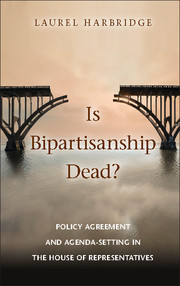Book contents
- Frontmatter
- Contents
- List of figures and tables
- Acknowledgments
- 1 Introduction
- 2 A Puzzle of Declining Bipartisanship
- 3 Strategic Partisan Agenda-Setting
- 4 Agenda-Setting and the Decline of Bipartisan Cooperation
- 5 Variation in Strategic Partisan Agenda-Setting
- 6 Strategic Partisan Agenda-Setting Across Policy Areas
- 7 District Responsiveness and Member-Party Relationships
- 8 The Past, Present, and Future of Bipartisanship
- Appendix
- References
- Index
1 - Introduction
Published online by Cambridge University Press: 05 March 2015
- Frontmatter
- Contents
- List of figures and tables
- Acknowledgments
- 1 Introduction
- 2 A Puzzle of Declining Bipartisanship
- 3 Strategic Partisan Agenda-Setting
- 4 Agenda-Setting and the Decline of Bipartisan Cooperation
- 5 Variation in Strategic Partisan Agenda-Setting
- 6 Strategic Partisan Agenda-Setting Across Policy Areas
- 7 District Responsiveness and Member-Party Relationships
- 8 The Past, Present, and Future of Bipartisanship
- Appendix
- References
- Index
Summary
With both parties becoming more homogeneous and less diverse, the nation’s political leaders have been freed to take harder positions, draw sharper lines and forsake the time-honored tradition of reaching across party lines to find common cause with the other side.
(Westphal 2004)This quote captures three key aspects of the conventional wisdom on rising partisanship in Congress: that members have become increasingly polarized into two separate and non-overlapping ideological camps, that bipartisan cooperation has fallen as a result, and that these changes work against desired and “time-honored” efforts to find common ground in the legislative process. Those most critical of partisanship go even further, arguing that it produces gridlock, stunts policy innovation, and diminishes responsiveness on any level. In essence, polarization damages effective democratic governance.
Just how well do we understand the roots of partisan conflict? Scholars have suggested that the existence of elite polarization is “largely noncontroversial” (Fiorina and Abrams 2008, 584). While there is controversy over the extent of polarization in the mass public, nearly all political observers agree that elected officials fall into two distinct camps, with few places of agreement between members of the two parties. Moreover, research clearly shows that party polarization in American politics, as measured by the ideal point estimates (i.e., ideological positions) of members in the two parties, has risen since the 1970s (e.g., McCarty et al. 2006; Theriault 2008). Rather than representing the full spectrum of the legislative process, however, these studies concentrate attention on just roll call voting. This book looks beyond (and before) roll call votes to explore the extent and timing of partisan conflict in the U.S. House of Representatives since the 1970s. Until we look beyond roll call votes, we cannot fully understand the roots of partisan conflict, separate the impact of individual members’ positions from that of party influence and agenda-setting, or gauge whether bipartisanship is, in fact, dead. A better understanding of these issues is a necessary first step toward evaluating the normative concerns that discussions of partisan conflict typically provoke, ranging from issues of governance and legislative action (or inaction) to issue attention across policy areas and representation.
- Type
- Chapter
- Information
- Is Bipartisanship Dead?Policy Agreement and Agenda-Setting in the House of Representatives, pp. 1 - 17Publisher: Cambridge University PressPrint publication year: 2015



